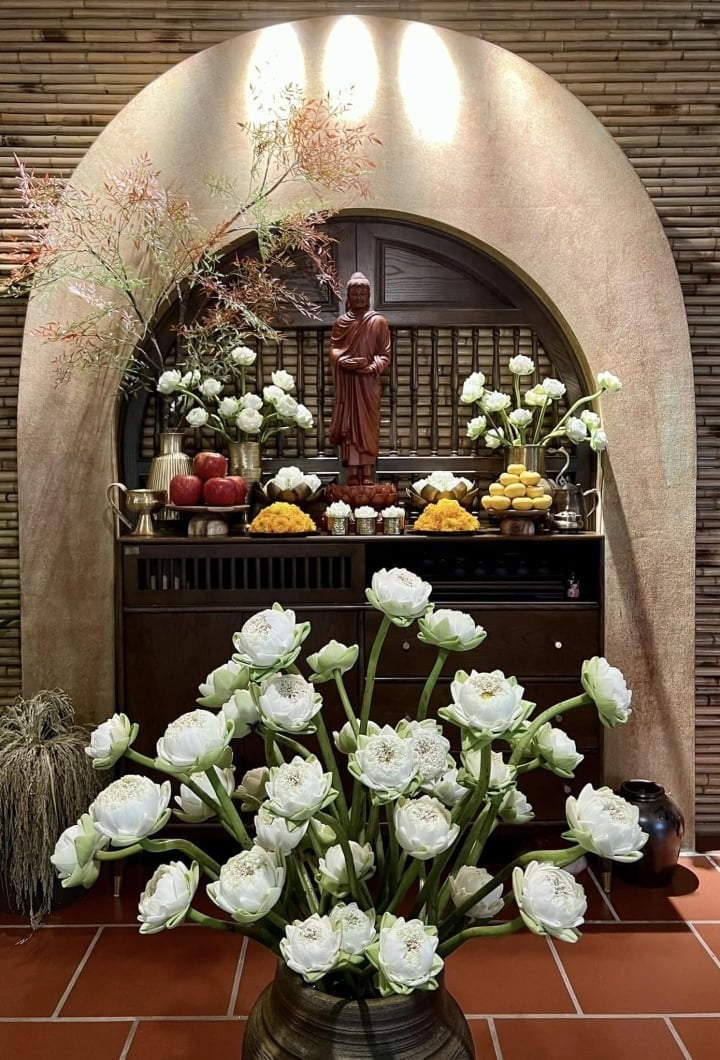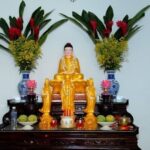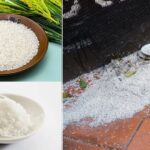The placement of a flower vase on the altar, whether on the left or right, may seem like a simple decision, but it is a question that often puzzles many. Ancestor worship is an extremely important belief for Vietnamese people.
Each family expresses their reverence and carefulness in arranging the altar, preparing offerings, and performing rituals. As a result, questions arise about how to set up the worship space, such as the location of the flower vase on the altar or what other items should be included.
Should the flower vase on the altar be placed on the left or right?
According to traditional beliefs, the position of the flower vase on the altar depends on the number of vases the host intends to use.
When there is only one flower vase
If there is only one flower vase, it is advisable to follow the principle of “east for flowers, west for fruits”. This means that the flower vase should be placed on the east side, while the tray of five types of fruits should be placed on the west side. This is an age-old principle of altar arrangement based on the natural law: the sun rises in the east and sets in the west, and trees must blossom before bearing fruit. Thus, the flower vase belongs on the east side, with the fruit tray on the west.
To determine the direction on the altar, stand facing the altar, then the left side of the ancestors (the left side) is considered the east, and the right side (the right side) is the west.

If there is only one flower vase, follow the principle of “east for flowers, west for fruits”
Typically, the family ancestor altar is placed in the center of the house, facing south. The flower vase will be placed on the left side of the altar (east). When the east or southeast wind blows, the fragrance of the flowers will permeate the worship space. The tray of five types of fruits will be placed on the right (west) for convenience.
When there are two flower vases
If the family ancestor altar is spacious, the host can consider placing two flower vases symmetrically on both sides. In this case, the tray of five types of fruits will be placed in the center of the altar, in front of the incense burner. This arrangement creates a sense of balance and elegance for the altar. However, depending on the area and space of the altar, the host can choose large or small flower vases and the number of flowers.
The significance of different types of flowers used for worship
Red Roses
Red roses symbolize not only love and happiness but also good luck and fortune. With their gentle and pleasant fragrance, red roses are a popular choice for offerings, expressing reverence and hopes for good things.
Apricot Blossoms
This type of flower usually blooms in spring and is favored during the Tet holiday in the South. A branch of apricot blossoms on the altar is a way to express gratitude to one’s ancestors and parents, bringing a fresh spring atmosphere. Apricot blossoms also symbolize wealth, prosperity, and good luck.

Apricot blossoms are favored during the Tet holiday in Southern Vietnam.
Yellow Chrysanthemums
Chrysanthemums are one of the most popular flowers for worship. Besides their striking appearance and long-lasting freshness, chrysanthemums also symbolize filial piety and respect for ancestors. They convey the idea of longevity and eternity.
Lotus Flowers
With their graceful beauty and pure fragrance, lotus flowers have become a symbol of Buddhism and are widely used in worship ceremonies. Lotuses represent purity and also symbolize inner strength, resilience, and steadfast faith.







































